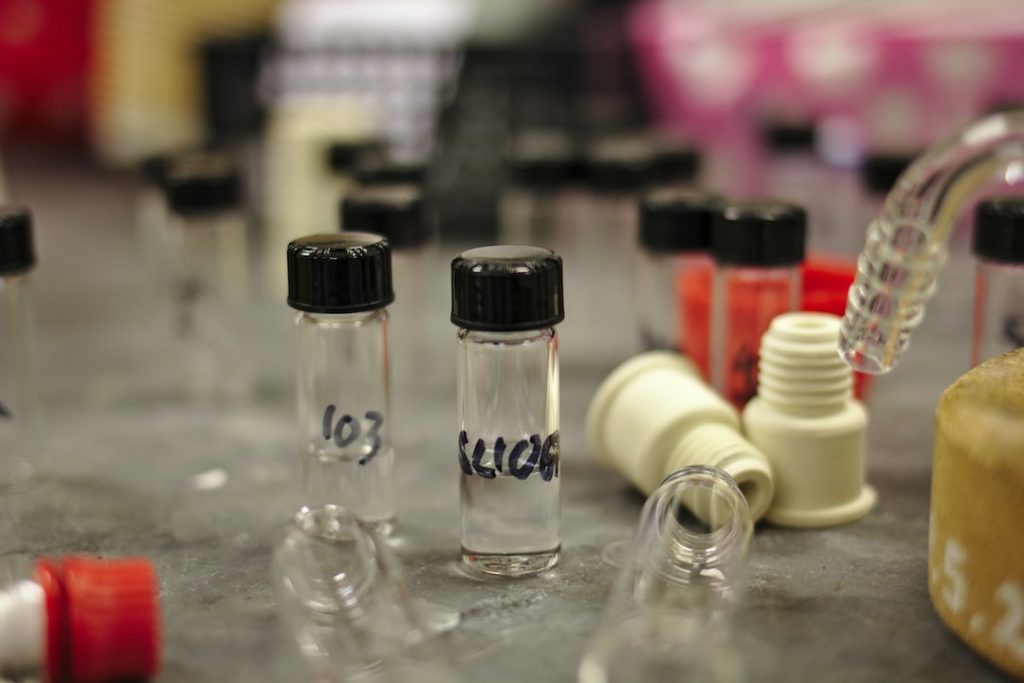Coordination chemistry is a branch of chemistry that deals with the study of compounds formed between metal ions and other molecules or ions, known as ligands. These compounds are called metal complexes and they play a crucial role in various fields such as catalysis, materials science, bioinorganic chemistry, and medicine.
The history of coordination chemistry can be traced back to the early 19th century when chemists began to study the properties of metal complexes. The field gained significant attention in the late 19th and early 20th centuries with the discovery of complex ions and the development of coordination theory by Alfred Werner. Werner’s work laid the foundation for our understanding of coordination compounds and earned him the Nobel Prize in Chemistry in 1913.
Coordination chemistry is important in various fields due to the unique properties exhibited by metal complexes. These compounds often have distinct colors, magnetic properties, and reactivity compared to their individual components. This makes them useful in a wide range of applications such as catalysis, where metal complexes can accelerate chemical reactions, and materials science, where they can be used to design new materials with specific properties.
Key Takeaways
- Coordination chemistry is the study of metal complexes and their properties.
- Metal complexes are important in many fields, including catalysis, materials science, and bioinorganic chemistry.
- Ligands and coordination numbers play a key role in the bonding of metal complexes.
- Spectroscopic techniques are used to study the properties of metal complexes.
- Coordination polymers have potential applications in areas such as gas storage and drug delivery.
What are Metal Complexes and Why are They Important?
Metal complexes are compounds formed by the coordination of a central metal ion with one or more ligands. Ligands are molecules or ions that donate electron pairs to the metal ion, forming coordinate covalent bonds. The metal ion acts as a Lewis acid, accepting electron pairs from the ligands.
Examples of metal complexes include transition metal complexes such as [Fe(CN)6]4-, which is a deep blue compound formed by the coordination of six cyanide ligands to an iron(II) ion, and [Cu(NH3)4(H2O)2]2+, which is a pale blue compound formed by the coordination of four ammonia ligands and two water ligands to a copper(II) ion.
Metal complexes are important in various fields due to their unique properties and reactivity. In catalysis, metal complexes can act as catalysts, accelerating chemical reactions by providing an alternative reaction pathway with lower activation energy. They can also exhibit specific selectivity towards certain reactions, making them useful in organic synthesis and industrial processes.
In materials science, metal complexes can be used to design and synthesize new materials with specific properties. For example, metal complexes can be incorporated into polymers to enhance their mechanical strength or conductivity. They can also be used as building blocks for the construction of coordination polymers, which have applications in gas storage, sensing, and separation.
Understanding the Bonding in Metal Complexes: Ligands and Coordination Numbers
Ligands are molecules or ions that donate electron pairs to the metal ion in a coordination complex. They can be classified into different types based on their electron-donating ability and the number of electron pairs they donate. Common ligands include water (H2O), ammonia (NH3), cyanide (CN-), and carbon monoxide (CO).
Ligands can be classified as monodentate, bidentate, or polydentate based on the number of donor atoms they possess. Monodentate ligands donate one electron pair to the metal ion, bidentate ligands donate two electron pairs, and polydentate ligands donate multiple electron pairs.
The coordination number of a metal complex refers to the number of ligands that are coordinated to the central metal ion. It is determined by the size and charge of the metal ion as well as the size and charge of the ligands. Common coordination numbers include 2, 4, 6, and 8.
The coordination number has a significant impact on the properties and reactivity of metal complexes. For example, complexes with a coordination number of 2 often exhibit linear geometries, while complexes with a coordination number of 4 often exhibit tetrahedral or square planar geometries. The coordination number also affects the stability of the complex, with higher coordination numbers generally leading to greater stability.
The Role of Metal Ions in Coordination Chemistry
| Metal Ion | Coordination Number | Coordination Geometry | Examples of Ligands |
|---|---|---|---|
| Cu(II) | 4 | Square Planar | NH3, CN-, Cl- |
| Zn(II) | 4 | Tetrahedral | H2O, NH3, Cl- |
| Fe(II) | 6 | Octahedral | H2O, NH3, CO, CN- |
| Co(III) | 6 | Octahedral | H2O, NH3, Cl-, OH- |
| Ni(II) | 6 | Octahedral | H2O, NH3, CN-, CO |
Metal ions play a crucial role in coordination chemistry due to their unique properties and reactivity. Metal ions often have a high charge density, which allows them to form strong electrostatic interactions with ligands. This leads to the formation of coordinate covalent bonds between the metal ion and the ligands.
The properties of metal ions, such as their charge and size, influence the coordination geometry of the resulting metal complex. For example, metal ions with a high charge and small size often form complexes with a high coordination number and a compact geometry. On the other hand, metal ions with a low charge and large size often form complexes with a low coordination number and an extended geometry.
The stability of metal complexes is influenced by several factors, including the nature of the metal ion, the nature of the ligands, and the coordination number. For example, metal ions with a high charge and small size tend to form more stable complexes due to their strong electrostatic interactions with ligands. Similarly, ligands with a high electron-donating ability tend to form more stable complexes due to their ability to donate electron pairs to the metal ion.
Spectroscopic Techniques for Studying Metal Complexes
Spectroscopic techniques are widely used in coordination chemistry to study the properties and structure of metal complexes. These techniques involve the interaction of electromagnetic radiation with matter, providing information about the energy levels and electronic transitions in the complex.
UV-Vis spectroscopy is commonly used to study the absorption of ultraviolet and visible light by metal complexes. This technique provides information about the electronic transitions that occur within the complex, allowing researchers to determine the energy levels and electronic structure of the complex.
IR spectroscopy is used to study the absorption of infrared light by metal complexes. This technique provides information about the vibrational modes of the complex, allowing researchers to determine the types of bonds present and the symmetry of the complex.
NMR spectroscopy is used to study the nuclear magnetic resonance properties of metal complexes. This technique provides information about the chemical environment and coordination geometry of the metal ion, as well as the structure and dynamics of the ligands.
X-ray crystallography is a powerful technique used to determine the three-dimensional structure of metal complexes. This technique involves the analysis of X-ray diffraction patterns produced by a crystal of the complex, allowing researchers to determine the positions of the atoms within the complex.
Applications of Coordination Chemistry in Catalysis and Materials Science

Coordination chemistry plays a crucial role in catalysis, where metal complexes are used as catalysts to accelerate chemical reactions. Homogeneous catalysis involves the use of soluble metal complexes in solution, while heterogeneous catalysis involves the use of immobilized metal complexes on solid supports.
In homogeneous catalysis, metal complexes can act as catalysts by providing an alternative reaction pathway with lower activation energy. They can also exhibit specific selectivity towards certain reactions, making them useful in organic synthesis and industrial processes.
In heterogeneous catalysis, metal complexes can be immobilized on solid supports such as zeolites or nanoparticles. This allows for easy separation and recycling of the catalyst, making it more sustainable and cost-effective.
Coordination chemistry also has important applications in materials science. Metal complexes can be used to design and synthesize new materials with specific properties. For example, metal complexes can be incorporated into polymers to enhance their mechanical strength or conductivity. They can also be used as building blocks for the construction of coordination polymers, which have applications in gas storage, sensing, and separation.
Bioinorganic Chemistry: Metal Complexes in Biological Systems
Bioinorganic chemistry is a field that focuses on the study of metal complexes in biological systems. Metal ions play crucial roles in biological processes, such as enzyme catalysis, electron transfer, and oxygen transport.
Metal ions are often found in the active sites of metalloproteins, which are proteins that contain metal ions as cofactors. These metal ions can act as Lewis acids, accepting electron pairs from ligands in the protein or substrate, and facilitating chemical reactions.
Metalloproteins have diverse functions in biological systems. For example, hemoglobin is a metalloprotein that contains iron ions and is responsible for oxygen transport in the blood. Cytochrome c is a metalloprotein that contains heme groups and is involved in electron transfer reactions in the respiratory chain.
Metal complexes also have important medical applications. For example, platinum-based complexes such as cisplatin are widely used as anticancer drugs. These complexes can bind to DNA and inhibit cell division, leading to the death of cancer cells.
Coordination Polymers: From Design to Applications
Coordination polymers are a class of materials that are formed by the self-assembly of metal ions or clusters with organic ligands. These materials have a repeating three-dimensional structure and can exhibit interesting properties such as porosity, magnetism, and conductivity.
Coordination polymers can be designed by carefully selecting the metal ions and ligands used in their synthesis. The choice of metal ion determines the coordination geometry and charge of the resulting polymer, while the choice of ligand determines the connectivity and flexibility of the polymer.
Coordination polymers have applications in various fields such as gas storage, sensing, and separation. For example, some coordination polymers can selectively adsorb gases such as carbon dioxide or methane, making them useful for gas storage or separation processes. Other coordination polymers can be used as sensors for detecting specific molecules or ions in solution.
Challenges and Opportunities in Coordination Chemistry Research
Synthesizing and characterizing metal complexes can be challenging due to their often complex structures and reactivity. The synthesis of metal complexes often requires careful control of reaction conditions such as temperature, pH, and stoichiometry. Characterizing metal complexes often requires the use of advanced spectroscopic techniques such as NMR or X-ray crystallography.
However, these challenges also present opportunities for developing new materials and catalysts. By understanding the factors that influence the stability and reactivity of metal complexes, researchers can design new ligands and metal ions that exhibit specific properties. This can lead to the development of new materials with enhanced mechanical, optical, or magnetic properties, as well as new catalysts with improved selectivity or activity.
Environmental and sustainability challenges are also important considerations in coordination chemistry research. Many metal complexes contain toxic or environmentally harmful elements such as heavy metals. Developing sustainable and environmentally friendly alternatives is an important goal in the field. This includes the use of non-toxic or abundant metal ions, as well as the development of recyclable or reusable catalysts.
Future Directions in the Field of Coordination Chemistry
The field of coordination chemistry is constantly evolving, with new areas of research emerging and advances in spectroscopic techniques enabling more detailed studies of metal complexes.
One emerging area of research is the study of metal-organic frameworks (MOFs), which are a subclass of coordination polymers with high porosity and surface area. MOFs have applications in gas storage, catalysis, and drug delivery due to their unique properties.
Advances in spectroscopic techniques such as time-resolved spectroscopy and single-molecule spectroscopy are also opening up new possibilities for studying the dynamics and reactivity of metal complexes at the molecular level. These techniques allow researchers to observe ultrafast processes and transient intermediates, providing valuable insights into reaction mechanisms.
The field of coordination chemistry also holds potential for applications in energy and medicine. For example, metal complexes can be used as catalysts for energy conversion and storage processes such as water splitting or carbon dioxide reduction. Metal complexes can also be used as imaging agents or drug delivery vehicles in medicine.
In conclusion, coordination chemistry is a diverse and interdisciplinary field that plays a crucial role in various areas of science and technology. The study of metal complexes and their properties has led to important advances in catalysis, materials science, bioinorganic chemistry, and medicine. With ongoing research and technological advancements, the field of coordination chemistry holds great promise for the development of new materials, catalysts, and applications in the future.
FAQs
What is coordination chemistry?
Coordination chemistry is the study of the interaction between metal ions and other molecules or ions, known as ligands, to form coordination compounds.
What are coordination compounds?
Coordination compounds are molecules that contain a central metal ion surrounded by ligands that are bonded to the metal ion through coordinate covalent bonds.
What are ligands?
Ligands are molecules or ions that bond to a central metal ion through coordinate covalent bonds. They can be neutral molecules or negatively charged ions.
What is a coordinate covalent bond?
A coordinate covalent bond is a type of covalent bond in which one atom donates both electrons to be shared with another atom.
What are some applications of coordination chemistry?
Coordination chemistry has applications in many fields, including medicine, materials science, catalysis, and environmental science. Coordination compounds are used as catalysts, drugs, and inorganic pigments, among other things.
What is chelation?
Chelation is the process of forming a complex between a metal ion and a ligand that has two or more donor atoms. The resulting complex is called a chelate.
What is a metal complex?
A metal complex is a coordination compound that contains a central metal ion bonded to one or more ligands.
What is a coordination number?
The coordination number of a metal ion is the number of ligands bonded to it. It is determined by the size of the metal ion and the size and charge of the ligands.


